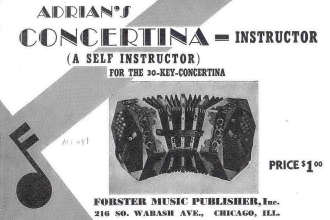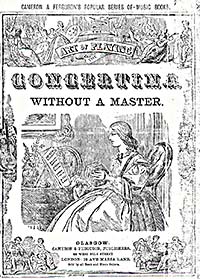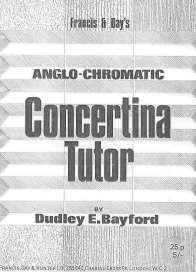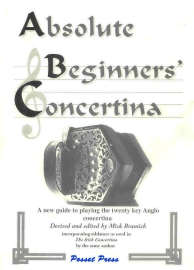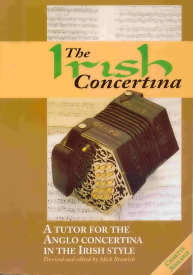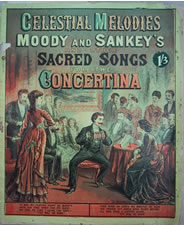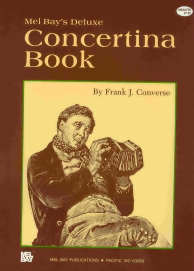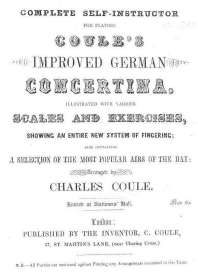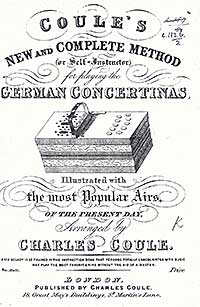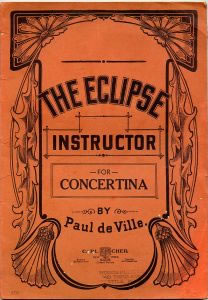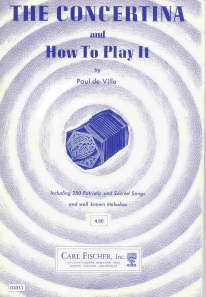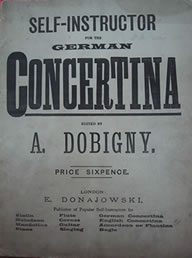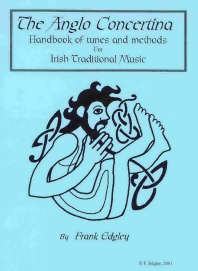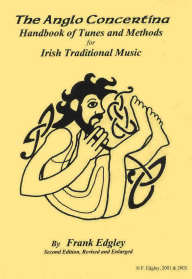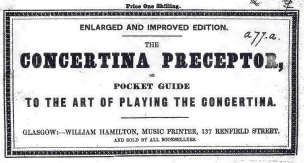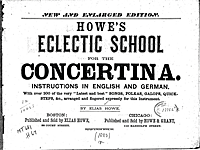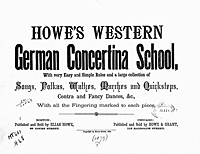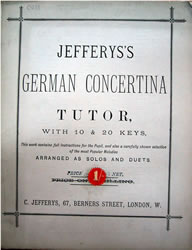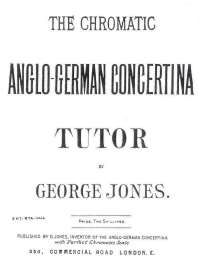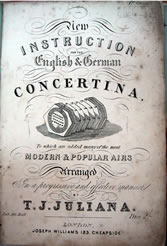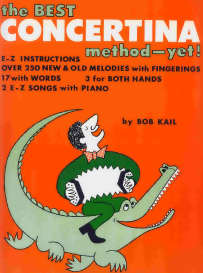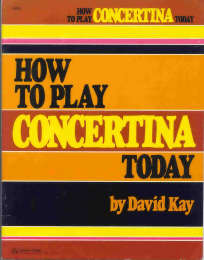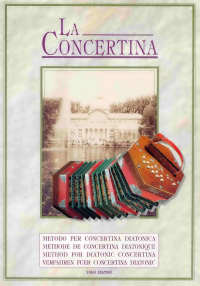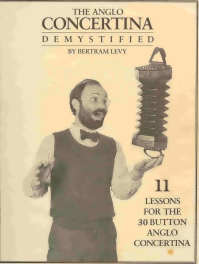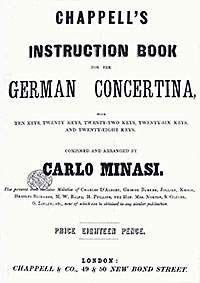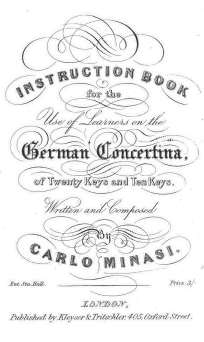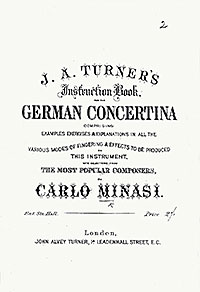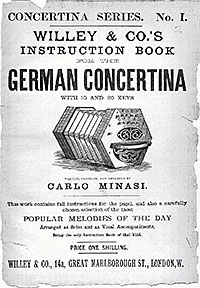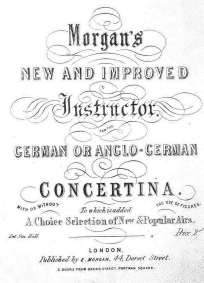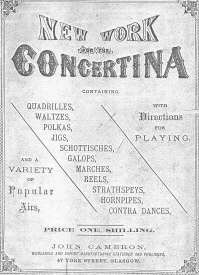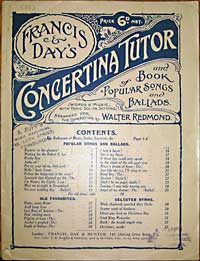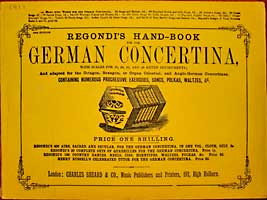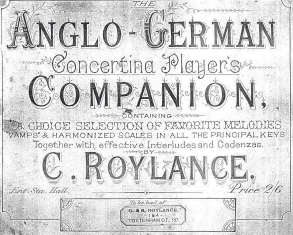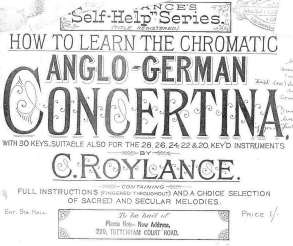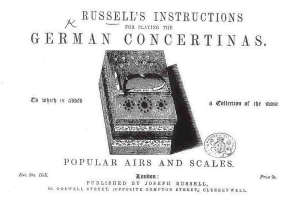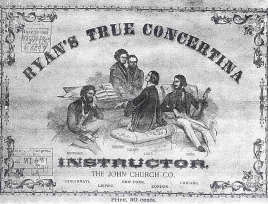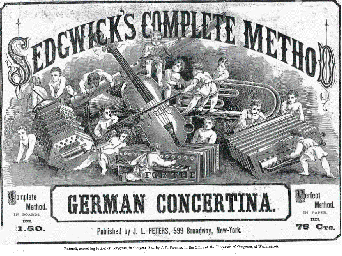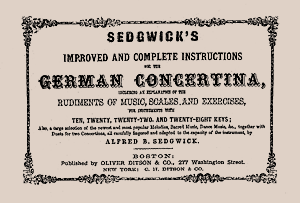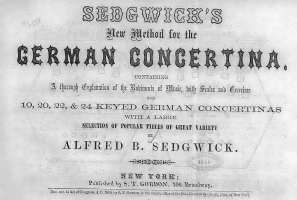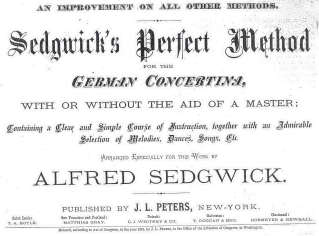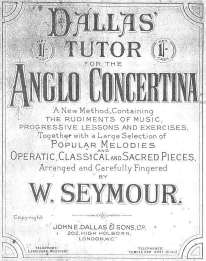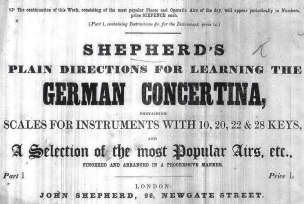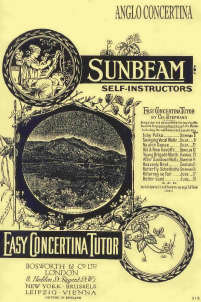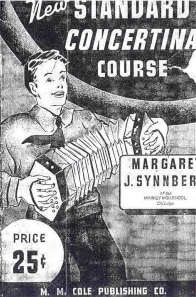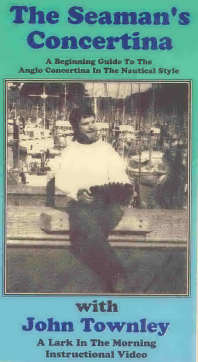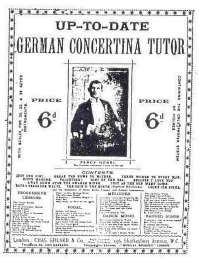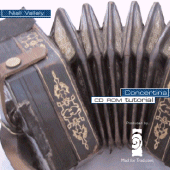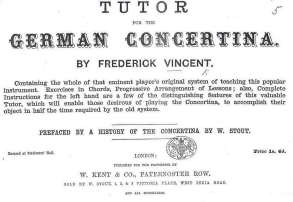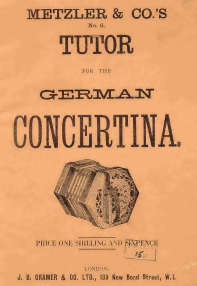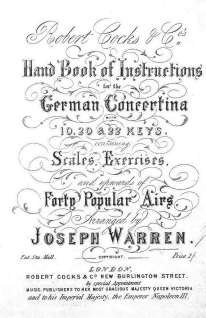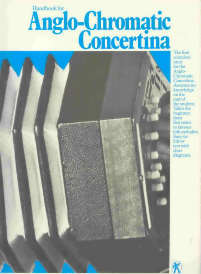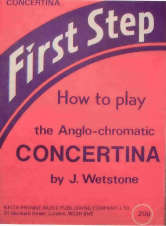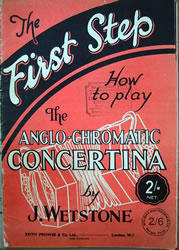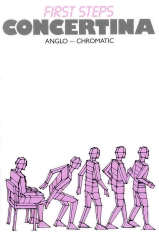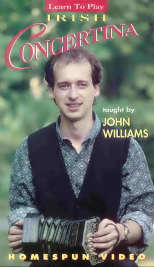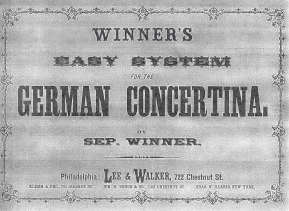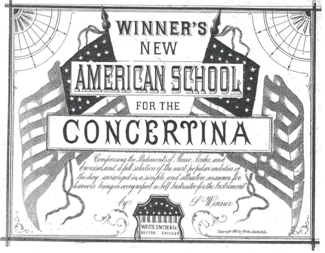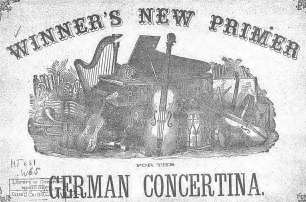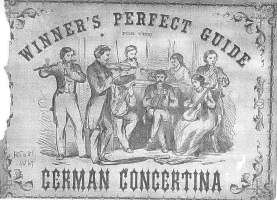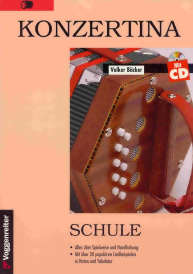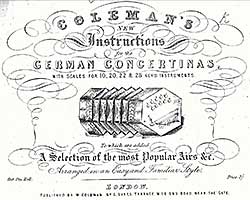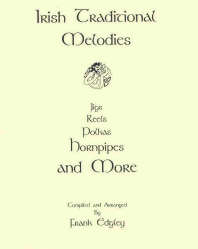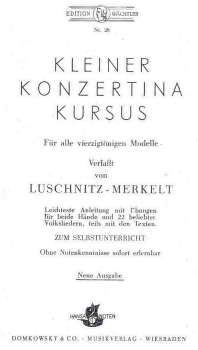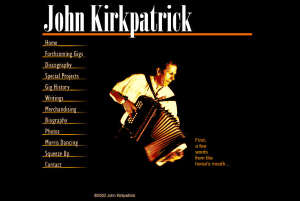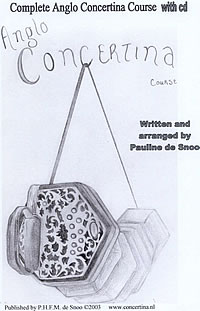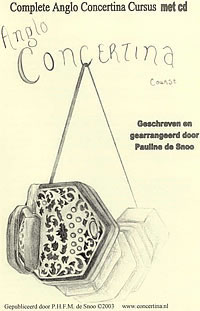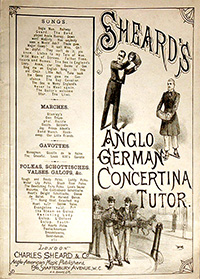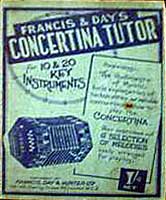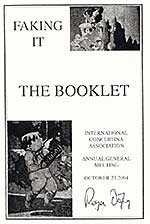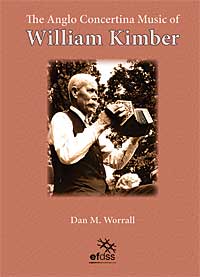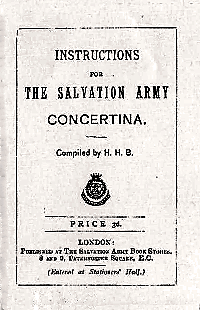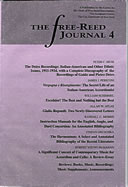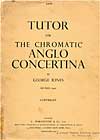Posted 01 April 2003
Instruction Manuals for the English, Anglo, and Duet Concertina:
An Annotated Bibliography
Randall C. Merris
Part II. Anglo Concertina
A1
Adams’ 100 Popular Irish Airs for the Concertina with a Concise Course of Instructions for
the Art of Playing the Concertina.
Glasgow: J. Cameron, c. 1860.
BL
The title refers to Alexander Adams, author of
The Musical Repository: A Collection of Favourite
Scotch, English, and Irish
Songs, Set to Music (Glasgow: A. Adams for A. Carrick,
bookseller, Saltmarket, 1799); see Frank Kidson,
British Music Publishers
(New York: Benjamin Blom, 1967), 201.
George Cameron began publishing about 1855, and his brother John in
1860 (Parkinson, Victorian Music Publishers, 44-45).
The Camerons and later Cameron & Ferguson, formed in 1871,
published many tutors and tune books for Anglo concertina and
several for English concertina.
A2
Adams’ 100 Scottish Airs for the Concertina
with Complete Instructions and Scales.
Glasgow: J. Cameron, c. 1860.
ADVERT
A3
Adrian, C.F.
Adrian’s Concertina-Instructor.
Chicago: Forster Music Publisher, 1938.
LC
A4
The Art of Playing the Concertina Without a Master.
Glasgow: Cameron & Co., c. 1863;
London: F. Pitman, c. 1863 (and subsequent edition, Cameron & Ferguson, c. 1872).
BL
A5
Bayford, Dudley Escott.
Francis & Day’s Anglo-Chromatic Concertina Tutor.
London: Francis, Day & Hunter, 1965.
HM, BL
A6
Bramich, Mick.
Absolute Beginners’ Concertina: A New Guide to the Twenty Key Anglo
Concertina.
Devon: Posset Press, 2000.
AVAIL
A7
———.
The Irish Concertina: A Tutor for the Anglo
Concertina in the Irish Style.
West Yorkshire: Dave Mallinson Publications, 1996
(CD or audio cassette available).
AVAIL
Provides in-depth instruction for playing
Irish tunes in several major and minor keys.
A8
Bremner, Louis.
A New Tutor for the German Concertina.
London: W. Williams & Co., 1862.
BL
A9
Cameron, George.
Cameron’s New and Improved Concertina Tutor, or Guide to the Art of
Playing the Concertina.
Glasgow: G. Cameron, 1860.
BL
A10
———.
Cameron’s Selection of Concertina Music: Containing Complete Instructions
and Scales, and a Variety of Popular Airs, Marked and Figured for the Ten, Twenty, Twenty-
Two, and Twenty-Eight Keyed German Concertina.
Glasgow: G. Cameron, 1857.
BL
A11
Cameron’s Concertina Dance Music, With Instructions.
Glasgow: J. Cameron, c. 1855.
ADVERT
A12
Cameron’s Concertina Tutor with Catechism.
Glasgow: J. Cameron, c. 1870.
ADVERT
A13
Celestial Melodies: Moody and Sankey’s and Other
Sacred Songs for the Concertina . . . The
Work Being Prefaced by A Course of Instructions for the Concertina.
Glasgow: Cameron & Ferguson, c. 1876.
HM
Probably published soon after Dwight L. Moody and Ira D. Sankey’s
first tour (1873-1875) of the British Isles.
A14
Chidley, Rock.
Chidley’s Instructions for the German Fingering Concertina.
London: R. Chidley, 1858.
BL
Chidley (1825-1894) started as a concertina assembler
at Wheatstone & Co. in the 1840s and became a Wheatstone
supervisor before starting his own concertina making
business. His concertinas were promoted in the tutor: “These
instruments being made by English workman under the
superintendence of R. C. . . . will be found very superior in tone to
those generally sold; having screwed notes, metallic action,
ivory keys, improved regulating straps, and in addition extra
notes which enable the performer to modulate into more keys
than the German Concertina” (p. 1). The tutor contains
illustrations of the layouts of keys for concertinas with
10, 20, 22, and 28 keys. The layout of Chidley’s 28-key concertina
had two 5-key rows and one 4-key row on each side.
The 4-key row was the top row on the left side and the bottom row on
the right side. The 28-key German-made concertina of that
era also had two 5-key rows and one 4-key row on each side, but
the 4-key row was the bottom row on each side of the instrument.
Both systems were relics before the end of the century.
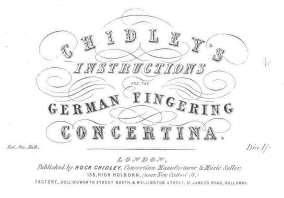
A15
The Complete Tutor for the Concertina.
Glasgow: Cameron & Ferguson, c. 1875.
ADVERT
A16
The Concertina Tutor, Or Guide to the Art of Playing the Concertina.
Glasgow: J. Cameron, 1883.
BL
A17
Converse, Frank J.
Mel Bay’s Deluxe Concertina Book.
Pacific, MO: Mel Bay Publications, 1981.
AVAIL
Bob Bolton’s review appears in Concertina Magazine
24 (1988): 23-24.
A18
Coule, Charles.
Complete Self-Instructor for Playing Coule’s Improved German Concertina.
London: C. Coule, 1856.
BL
Coule’s “improved German concertina” was a short-lived system:
“the performer is enabled to play all the principal Natural
notes, Double Action, on the Instrument, that is, by either
drawing out, or pressing in the bellows . . .” (p. 1). The keys—all
single-action—were arranged in two 6-key rows
on each side. His “Double Action” refers to a given note being available in each
bellows direction, pushing for one key and drawing for another key.
A19
———.
New and Complete Method (or Self-Instructor) for Playing the German
Concertinas.
London: C. Coule, 1852.
BL
“The Concertina is. . .in every way entitled to the
notice and patronage of the lovers of Music . . . [T]his small but expressive
little instrument, so enchants the ear that few persons
can fail to admire its sweetness and beauty” (p. 1).
A20
Cramer’s Instruction Book for the German Concertina.
London: Cramer & Co., 1873.
BL
A21
Curwen, John.
The German Concertina Book for Tonic Sol Fa Pupils.
London: J. Curwen, 1864.
BL
A22
De Ville, Paul.
The Eclipse Self Instructor for Concertina.
New York: Carl Fischer, 1905.
LC
Later titled
The Concertina and How to Play It ( AVAIL),
which retained the original contents except with “the concertina”
replacing “the German or Anglo-Saxon concertina.”
The music and tablature for 208 of the 250 tunes in De Ville’s book
were taken from Howe’s
Eclectic School for Concertina
( A33)
and Howe’s Western German Concertina School
( A36).
A23
Dobigny, A.
Self-Instructor for the German Concertina.
London: E. Donajowski, c. 1885.
HM
A24
Edgley, Frank C.
The Anglo Concertina: Handbook of Tunes and Methods for Irish
Traditional Music.
Windsor, Ontario: F. J. Edgley, 2001; 2nd ed., revised
and expanded, 2002. (CD included)
AVAIL
(see http://www.concertinas.ca)
Edgley teaches and performs on the Anglo concertina,
Northumbrian and Scottish small pipes, and tinwhistle. He also builds
and repairs concertinas. The handbook and CD, which
include detailed coverage of embellishments and variations, provide a
course for beginning and advanced players of
Irish-style concertina, emphasizing the North County Clare style of Chris
Droney, Tommy and Jacqueline McCarthy, and others. In addition to relatively
minor revisions, the second edition
contains some material on chords and fingerings, three
tunes, and six CD tracks that were not in the first
edition.
A25
Felton, William Matthew Horace.
The Melodeon, Concertina, and Accordion: Instructions on
How to Play, Tune, and Repair.
Dover: Standard Office, 1903.
BL
A26
Francis & Day’s Sixpenny Popular German Concertina Tutor,
with Sol-fa Supplement.
London: Francis, Day & Hunter, 1904.
BL
A27
German Concertina Instructor.
Boston: Oliver Ditson; and St. Louis: Balmer & Weber, c. 1865.
BMTCC
A28
Hamilton, William.
The Concertina Preceptor, or Pocket Guide to the Art of Playing the
Concertina Without a Master.
Glasgow: John Cameron, 1850 and 1855; and Cameron & Ferguson, 1883.
BL
A29
Harding, Joseph R. W.
New and Complete Method for the German Concertina, With Scales
for 10, 20, 22, and 28 Keys.
London: Metzler & Co., 1858.
BL
A30
Howard & Co.’s German Concertina Tutor.
London: Howard & Co., 1884.
BL
A31
Howard & Co.’s New and Improved German Concertina Tutor.
London: Howard & Co., 1875.
BL
“New and Improved” implies that there may have been a pre-1875 edition.
A32
Howe, Elias, Jr.
The Concertina Without a Master.
Boston: Elias Howe, c. 1846
(later published by Oliver Ditson and Balmer & Weber).
BMTCC
A32
Howe, Elias, Jr.
New German Concertina School.
Boston: Elias Howe, 1846
(probably an alternative title
for the same tutor). OSS
Howe (1820-1895) was a well-known fiddler, tune
collector, music publisher and dealer, and instrument manufacturer and
collector. He published more than two hundred books,
including tune books, dance books, and tutors for many musical
instruments. Two of his tune collections— The
Musician’s Companion (1840) and Ryan’s Mammoth
Collection
(c. 1883)—are especially well known. He is sometimes
confused with Elias Howe Jr. (1819-1867), the sewing machine inventor. On
Howe and his publications, see Patrick Sky,
Ryan’s Mammoth Collection
(Pacific, MO: Mel Bay Publications, 1995), 10-19;
The New Grove Dictionary of American Music,
ed. H. Wiley Hitchcock and Stanley Sadie (New York: MacMillan, 1986) 2,
435; and Christine Merrick Ayars,
Contributions to the Art of Music in America
by the Music Industries of Boston, 1640 to
1936 (New York: H.W. Wilson, 1937), 12-15.
Predating the 1850 sale of Howe’s music catalogue to Oliver Ditson
Company (see A35),
the tutor in this entry was
published at about the same time as Howe’s The Accordeon
Without a Master (Boston: Elias Howe, 1846).
A33
———.
Howe’s Eclectic School for the Concertina.
New and enlarged ed. Boston: Elias
Howe, 1879 (in English and partly in German).
LC
A34
———.
Howe’s New Concertina Without a Master and Concertina Exercises.
Boston:
Elias Howe; and St Louis: Balmer & Weber, c. 1870.
BMTCC
A35
———.
Howe’s New German Concertina.
Boston: Oliver Ditson, c. 1855.
BMTCC
In 1850, Howe sold his music catalogue to the
Oliver Ditson Company in a deal that precluded Howe from publishing music
for ten years. Howe skirted the agreement by publishing
many books of dance instruction during the 1850s. This tutor was
published during the term of Howe’s “banishment.” The Oliver
Ditson Company—a major manufacturer of musical
instruments (but not concertinas) and music publisher—became
the dominant U.S. publisher of concertina tutors. Ditson
purchased the entire firms or music catalogues of rival
publishers for concertina—Firth, Pond, & Co.
(in 1867), Lee & Walker (in 1875), and J. L. Peters
(in 1877)—and was a founding partner of John Church & Co.;
see William A. Fisher, One
Hundred and Fifty Years of Music Publishing in the United States
(Boston: Ditson, 1933).
A36
———.
Howe’s Western German Concertina School.
Boston: Elias Howe, 1879.
LC
A37
Jefferys’s German Concertina Tutor, With 10 & 20 Keys.
London: C. Jefferys, c. 1885.
HM
Charles Jefferys, music publisher, should not
be confused with Charles Jeffries, the well-known concertina maker.
A38
Jewell, Philip.
Instructions for Playing Davis’s New
Patent Chromatic German Concertina.
London: The Music Publishing Company, 1862.
BL
Jewell was granted the first British patent for the
Anglo-chromatic concertina. His patent (“Concertinas,” August 29, 1861;
Patent No. 2152) included another innovation that was
short-lived: “ . . . parallel plates of glass . . . by which
the tone . . . will be modified and improved.” In his tutor,
Jewell states that “The concertina being an Instrument so well
known, it is
unnecessary to enter into any description . . . further
than to explain the great improvements in . . . the ‘New Patent Chromatic
German Concertina’ . . .” (p. 1). However,
the Anglo concertina with an extended set of notes was not entirely new.
Although George Jones
(see A39) was making models
with 26 or more keys in the 1850s (Wayne, Concertina Book,
60), he did not patent his extended-range (42-key)
Anglo concertina until 1884 (“Improvements in Anglo-German Concertinas,”
June 23, 1884; Patent No. 9314). In the 1850s,
Rock Chidley
(see A14) was also making Anglo
concertinas with more than
20 keys. British claims of invention disregarded
the 28-key German concertina—well-known in Britain in the 1850s (see
A10,
A29, and
A82)—and other
early chromatic-type
concertinas from Saxony. Davis presumably was the maker of
Jewell-designed concertinas; he is referred to only in the
tutor title.
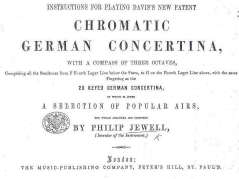
A39
Jones, George Smith.
Scales and Chords Arranged for the New Patent Anglo-German
Concertina.
London: G. Jones, 1884.
BL
Jones (1832-1919) was the self-proclaimed
“inventor of the Anglo-German concertina with perfect
chromatic scale.” Early
in his career, Jones worked for Jabez Austin, who made
reed pans for Wheatstone & Co., and
performed on German (i.e., Anglo) concertina and flutina in the
music halls. He invented a portable harmonium, wrote concertina
and banjo tutors, sold musical instruments, and taught
music. From the 1850s to 1909, George Jones & Co.
(later, & Sons) produced thousands of concertinas. After Jones retired
in 1899, his firm survived for a decade under the management
of his children. George Jones’s life is described in his own
words in
“Recollections of the English Concertina, from 1844,
by George Jones, born February 29th 1832”, Concertina
Magazine Part I: 13 (Winter 1985): 4-5,
Part II: 14 (Spring 1986): 4-7, on the web at
www.concertina.com/jones;
also published in part as
Frank E. Butler and Neil Wayne,
“The Concertina
Trade in Victorian Times”, Free Reed: The Concertina Newsletter, 16 (1973),
14-20, on the web at www.concertina.com/jones.
Frank Butler,
“Concertinas in the Commercial Road:
The Story of George Jones”,
Concertina & Squeezebox 20 (Summer 1989): 5-14,
on the web at www.concertina.com/butler.
His concertina students included the famous comic/concertina
duo of the Brothers Webb (Arthur and Joe); see Frank Butler,
“The Webb Brothers”,
Concertina & Squeezebox 18-19 (1989): 11-15,
on the web at www.concertina.com/butler.
A40
———.
The Chromatic Anglo-German Concertina Tutor.
London: G. Jones, 1876.
OSS
A 1989 reprint by Concertina & Squeezebox is no longer available.
A41
Juliana, T. J.
New Instruction for the English & German Concertina.
London: Joseph Williams, c. 1870.
HM
One of two tutors written for both English and Anglo concertina
(= E32;
see also A73).
A42
Kail, Bob.
The Best Concertina Method—Yet!
Carlstadt, NJ: Lewis Music Publishing, 1975.
AVAIL
Contains reprints of all but one of the 250 tunes in
De Ville’s book (see A22),
as well as some songs arranged by Kail.
A43
Kay, David.
How to Play Concertina Today.
Miami Beach: Shattinger International Music, 1980.
AVAIL
A44
La Concertina: Method for Diatonic Concertina.
Stagi Edition. Recanati: Brunner Musica, c. 1995.
AVAIL
A45
Lärobok för Nybörjare å Frålaningsarmens Konsertina.
Stockholm: Stridsropets Tryckeri, 1909.
OSS
The English translation is
Tutor for Beginners on the Salvation Army Concertina.
The tutor indicates that the Salvation
Army concertina is in the key of A flat, but that the
instructions are compatible with the Anglo concertina in the keys of C
and G major.
A46
Levy, Bertram.
The Anglo Concertina Demystified:
Eleven Lessons for the 30-Button Anglo
Concertina.
Voorheesville, NY: Front Hall Enterprises, 1985. (book and two audio cassettes)
AVAIL
A full-fledged “self-instruction course” for
beginning and advanced Anglo concertina players, it contains instructions for
playing melody and accompaniment for folk, Morris-dance,
Irish, and other styles of music. A review appears in John Green
and John Townley, “Bertram Levy: The Maestro Makes His Mark,”
Concertina & Squeezebox 3:1-2 (Winter-Spring 1985):
45-47.
A47
Maynard, Richard Frederick William.
Maynard’s New German Concertina Tutor and Budget
of Popular Songs, Ballads, &c.
London: R. Maynard, c. 1895.
BL
A48
Millet’s German Concertina Instructor.
New York: William B. Millet, c. 1870.
BMTCC
A49
Minasi, Carlo.
Instruction Book for the German Concertina.
London: Chappell & Co., 1858.
BL, HM
Minasi was a prolific author of music books and arranger of
music (see E41).
A50
———.
Instruction Book for the Use of Learners of the German
Concertina, of Twenty
Keys and Ten Keys.
London: Kleyser & Tritschler, 1846.
BL
Contained “medallions” to cut out and paste on the
instrument to label the keys. Minasi, like other authors, promoted the
instrument as easy to learn: “The German Concertina
is confidently recommended as an instrument of much power and
variety, and one upon which great execution can be
attained with comparatively little practice” (p. 1).
The firm of Kleyser & Tritschler dealt in German clocks and toys;
see A Directory of London and Its Suburbs
(London: J. Pigot & Co., 1839), 242.
A51
———.
J. A. Turner’s Instruction Book for the German Concertina.
London: J. A. Turner, 1864.
BL
John Alvey Turner was one of the earliest dealers in
English-made concertinas. Wheatstone sales records show his purchase
of several concertinas in 1843, the year that he became a publisher;
see Wayne, Concertina Book, 37;
Parkinson, Victorian Music Publishers, 274.
A52
———.
Minasi’s Tutor for the German Concertina.
London: Boosey & Co., c. 1870.
ADVERT
A53
———.
New German Concertina Album and
Tutor for the 20 Keyed Instrument.
Braunschweig: H. Litolff, 1880.
BL
A54
———.
Willey & Co.’s Instruction Book for the
German Concertina with 10 and 20 Keys.
London: Willey & Co., 1886.
BL
A55
Mitchison’s Celebrated Concertina Tutor.
Glasgow: Mitchison & Co., c. 1880.
ADVERT
A56
Morgan, Edward.
Morgan’s New and Improved Instructor for the
German or Anglo-German Concertina.
London: E. Morgan, 1858.
BL
A57
The New Sixpenny Anglo-German Concertina Tutor.
London: Charles Sheard & Co., c. 1890.
ADVERT
A58
New Work for the Concertina . . . With Directions
for Playing and a Variety of Popular Airs.
Glasgow: John Cameron, c. 1850 and 1883.
HM, BL
Concerning the date of first publication, the introduction states:
“The Musical World, some five and twenty years back, was
amused . . . by the introduction of a rude little instrument
named the ‘Mouth Harminicon’.”
A59
Redmond, Walter.
Francis & Day’s Concertina Tutor and
Popular Song Book for 1891.
London: Francis, Day & Hunter, 1891.
BL
A60
———.
Francis & Day’s Concertina Tutor:
New Edition for 1889.
London: Francis Brothers & Day, 1888.
BL
A61
———.
Francis & Day’s German Concertina Tutor.
London: Francis & Day, 1881.
BL
A62
———.
Francis & Day’s German Concertina Tutor
and Book of Popular Songs and Ballads.
London: Francis, Day & Hunter; New York: T. B. Harms, 1893.
BL, HM
A63
Regondi’s Concertina Melodist,
Fingered for the German Instrument.
Nos. 1-14. London: Charles Sheard, 1854-1862.
BL (No. 6 only)
Although the title suggests that it is a collection of
musical arrangements, it also includes lessons and exercises. Regondi
supposedly had no input into the Anglo concertina tutors
and songbooks bearing his name. On Regondi’s brilliant career as a
guitarist and performer-composer-arranger-teacher of
music for English concertina,
see E51.
A64
Regondi’s German Concertina Tutor.
New and Enlarged Edition.
London: Charles Sheard & Co., c. 1890.
ADVERT
Long after Regondi’s death in 1872, the publisher was
still capitalizing on Regondi’s name in tutor and songbook titles.
A65
Regondi’s Hand-Book for the German Concertina.
London: Charles Sheard & Co., c. 1895.
HM
The cover states “And Adopted for the Octagon, Sexagon, or
Organ Celestial, and Anglo-German Concertinas.” Beginning
in 1859, George Jones made “Celestial” English and Anglo
concertinas—larger instruments that were prized (especially by
the Salvation Army) for the vibrato effect of
their double reeds
(Wayne, Concertina Book, 59-60).
The reference to “Charles Sheard & Co., Music Publishers
and Printers, 192 Hilborn” on the cover provides clues
for dating. Though the firm of
Sheard was located at the Hilborn address from
1851 to 1900, its name became Charles Sheard & Co. only in 1890; see
Parkinson, Victorian Music Publishers, 248-49.
A66
Regondi’s Up-to-Date German Concertina Tutor.
new ed., London: H. Darewski, 1920 (?).
BL
A67
Roylance, Charles George.
Anglo-German Concertina Player’s Companion.
London: Roylance, 1889.
BL, CSFRI, HM
A68
———.
How to Learn the Chromatic Anglo-German Concertina.
London: C. Roylance, 1878.
CSFRI
A69
———.
How to Learn the German Concertina.
London: C. Roylance, c. 1870.
ADVERT
A70
Henry Russell’s Celebrated Tutor for the
German Concertina.
London, Charles Sheard & Co., c. 1890.
ADVERT
Russell (1812-1900)—an English pianist, singer,
and songwriter—was the most famous composer of American popular
songs before Stephen Foster (who was directly influenced
by Russell). Russell resided in New York from 1835 to 1845, and
engaged in songwriting, solo concerts (piano and vocal),
and short careers as a church organist, choirmaster, and music
academy teacher; see
New Grove Dictionary of American Music 4, 111-12.
Considering Sheard’s propensity for inserting
celebrities’ names in their titles, it is unlikely
that Russell had anything to do with the tutor.
A71
Russell, Joseph.
Russell’s New and Improved Self-Instructor
for the German Concertina.
London: J. Russell, 1854.
BL
A72
Ryan, Sydney.
Ryan’s True Concertina Instructor.
Cincinnati, OH: John Church, 1875 and 1903.
LC
This was the only concertina tutor sold through
the mail order of Sears, Roebuck, & Co.
(1899-1903 catalogues). Sydney
Ryan was a well-known composer-arranger, not to be confused with
William Bradbury Ryan, author of Ryan’s Mammoth
Collection (see A32).
A73
The Salvation Army Anglo-German and
English Concertina Tutor.
London: [Salvation Army] Publishing Offices, 1905.
BL
One of two tutors expressly written for both Anglo and
English Concertina
(= E60;
see also A41).
Earlier, Herbert Booth, son of
Salvation Army founder William Booth, wrote a booklet
(title and date unknown) on concertina chords for Salvation Army
players. From Burgess’s description, it appears that
Booth’s booklet was for Anglo concertina; see Burgess, “100 Years of
Concertinas,”
Concertina Magazine 24 (1988): 12.
[ Added 2005: Now see A117
for bibliographical details of Booth's booklet on chords.]
A74
Sedgwick, Alfred B.
Sedgwick's Complete Method for the German Concertina.
New York: J. L. Peters, 1865.
LC
A75
———.
Sedgwick’s Improved and Complete Instructions
for the German Concertina.
New York: Firth and Son, 1865; Boston: Oliver Ditson, 1893.
BL, LC
Though Sedgwick
(see E63) had an
undisguised disdain for the Anglo concertina,
he wrote some of the most advanced (and
arguably best) Anglo concertina tutors. In this tutor,
he proclaimed the superiority of the English concertina: “. . . a perfect
instrument capable of producing the more
elaborate and intricate harmonizing . . .” (p. 23).
He was more outspoken in his
New Method for the English Concertina
( E65):
“The English concertina is . . . far superior . . . to that
known as the German concertina, which as compared to the former,
can only rank as a mere toy” (pp. 9-10).
A76
———.
Sedgwick’s New Method for the German Concertina.
New York: S.T. Gordon, 1869.
LC
A77
———.
Sedgwick’s Perfect Method for the German Concertina.
New York: J. L. Peters, 1873.
LC
Sedgwick counseled that “. . . the Concertina should be lightly
waved in the air. By waving I do not mean swinging. There
are some performers who appear to think that it is impossible
to play without tossing the instrument round and round as if
they were a windmill and their arms the sails . . . [I]t is decidedly
injurious to the instrument and liable to cause the breaking
of reeds, besides making it sound out of tune; and also causing
the player to appear more like a buffoon than an artist” (p.
18). He probably was relying on his memory of performers
in the British music halls, rather than on the American stage. I
have found only two concertinists in nineteenth-century
American minstrelsy—virtuoso James Sharpley (1845-1902) and
William F. Hoey, a black-face comedian/concertinist
who first appeared on the minstrel stage in 1873; see Edward LeRoy Rice,
Monarchs of Minstrelsy, From “Daddy Rice” to Date
(New York: Kenny Publishing, 1911), 182, 264.
A78
Seymour, W.
Dallas’ Tutor for the Anglo Chromatic Concertina.
London: John E. Dallas & Sons, c. 1920.
ADVERT
A79
———.
Dallas’ Tutor for the Anglo Concertina.
London: John E. Dallas & Sons, c. 1920.
HM
A80
Shepherd, John.
Shepherd’s Plain Directions for Learning the
German Concertina.
London: J. Shepherd, 1856.
BL
A81
Sinclair’s New and Improved German Concertina Tutor.
London: J. Bath, 1873.
BL
A82
Steers, Frederick A.
Steers’s Instructions for the German Concertina, Containing
Explanatory Scales for the 10, 20, 22, and 28 Key’d Instruments.
London: F. Steers, 1860.
BL
Promotion of the tutor was based on both utility and
price; as the cover states, “Persons totally unacquainted with Music can
play the figured [i.e., tablatured] Melodies without
the slightest aid of a master . . . This instructor will be sent,
(Post paid), to
any part of the United Kingdom, upon receipt of 12 Postage Stamps.”
A83
Stephano, Charles (pseud.).
Wickins’ Easy Concertina Tutor.
Wickins’ Sunbeam Music
Books, No. 12. London: Bosworth & Co., 1897.
BL, CSFRI, AVAIL
Stephano’s real name was Alfred William Rawlings;
he was a prolific arranger of secular and sacred music. The tutor is
available in a reprint (Oxford: Hands on Music, 1998).
A84
Synnberg, Margaret J.
New Standard Concertina Course.
Chicago: M. M. Cole, 1938.
LC
Synnberg was a music teacher in a Chicago high school.
Her 16-page method—reissued as Concertina—Self Instruction
Method (Chicago: M. M. Cole, 1965)—was provided
along with many Anglo concertinas sold in the United States.
A85
Townley, John.
The Seaman’s Concertina:
A Beginning Guide to the Anglo Concertina in the
Nautical Style.
Mendocino, CA: Lark in the Morning Instructional Video, 1987.
AVAIL
Instructional video without printed music or tablature.
John Townley was an editor of Concertina and Squeezebox.
An anonymous review appears in
Concertina & Squeezebox 23 (Summer 1990): 11.
A86
Up-To-Date German Concertina Tutor.
London: Charles Sheard & Co., c. 1900.
OSS
A photograph of Percy Honri and the caption “The Greatest
Concertina Player of the Age” appears on the cover. The
photograph, which appears to be from a set taken in New York
in 1899, is reproduced in Concertina Magazine 2 (Spring
1982): 23. Sheard used celebrity “endorsements” without regard
for the concertinas that the celebrities played. Percy Honri
(1874-1953) was a star performer, but on the duet concertina.
With respect to the dating, Charles Sheard & Co.’s address is given
as 196 Shaftesbury Avenue, the firm’s address as of 1900
(Parkinson, Victorian Music Publishers, 248).
A87
Vallely, Niall.
Concertina CD ROM Tutorial.
Cork City: MadForTrad, 2002.
AVAIL
(order on-line at
http://madfortrad.com).
Vallely, concertinist in the former Nomos band and music
teacher, has toured with Irish singer Karan Casey. The tutorial
combines video, audio, text, and music notation to teach
beginning-to-advanced students of Irish-style concertina.
A88
Vincent, Frederick.
Tutor for the German Concertina.
London: W. Kent & Co., 1865.
BL
The tutor is prefaced by “A Brief History of the Concertina”
by W. Stout, who states that: “The English Concertina was
made some years before the German instrument bearing its
name, but, owing to its high price, and the immense difficulty of
playing it perfectly, it never could become a favourite with
the industrious class. Soon after the Exhibition of 1851, an
instrument became known in England as the German concertina . . .” (p. 1).
A89
Wade, James Augustus.
Metzler and Co.’s Tutor for the German Concertina.
London: Cramer & Co., 1886.
HM
Wade arranged a large volume of music, especially for piano.
A90
Warren, Joseph.
Robert Cocks & Co.’s Hand Book of Instruction for the
German Concertina with 10, 20, and 22 Keys.
London: Robert Cocks & Co., 1855 and 1858.
BL
A91
Watson, Roger.
Handbook for Anglo-Chromatic Concertina.
London: Wise Publications, 1981.
AVAIL
The hype on the cover, rivaling that on his English
concertina handbook
( E70),
exaggerates the contents: “The first
complete tutor for the Anglo-Chromatic Concertina.”
A92
Wetstone, J.
The First Step: How to Play the Anglo Chromatic Concertina.
London: Keith, Prowse & Co., 1935.
HM, LC
Reissued as First Steps: Concertina, Anglo-Chromatic
(Essex: International Music Publications, 1993). AVAIL
A93
Williams, John.
Learn to Play Irish Concertina.
Woodstock, NY: Homespun Video, 1995.
AVAIL
Williams, an All-Ireland Senior Concertina Champion
and music teacher, was formerly a member of the Solas band. The
video, accompanied by a booklet in standard musical notation,
is an instructive and enjoyable introduction to playing in the
Irish style.
A94
Wilson, G. F.
Wilson’s Complete Self Instruction
Book for the German Concertina.
London: H. Lea, 1857.
BL
A95
Winner, Septimus.
Winner’s Easy System for the German Concertina.
Philadelphia: Lee & Walker, 1869; Boston: Oliver Ditson, 1897.
LC
Septimus Winner (1827-1902) was author and/or publisher of
at least two hundred instruction books for more than twenty
instruments. His many songs included “Listen to the Mockingbird”
(under the pseudonym Alice Hawthorne) and “Der
Deitcher’s Dog” (known today as “Where, Oh Where Has My Little
Dog Gone”). He gained fame (or notoriety) in 1862,
when he was arrested on a charge of treason for publishing
“Give Us Back Our Old Commander: Little Mac, the People’s
Pride,” written in response to General George McClellan
being relieved of his Union Army command. He was released from
jail after agreeing to destroy all remaining copies,
but the song survived as a McClellan campaign song in the 1864 election.
His brother, Joseph Eastburn Winner, composed
“The Little Brown Jug.” See
New Grove Dictionary of American Music 4,
542; and Charles E. Claghorn,
Biographical Dictionary of American Music
(West Nyack, NY: Parker, 1973), 480.
A96
———.
Winner’s New American School for the Concertina.
Boston: White & Smith, 1883.
LC
A97
———.
Winner’s New Primer for the German Concertina.
New York: William A. Pond & Co., 1897.
LC
An earlier edition (no date) is listed in BMTCC.
A98
———.
Winner’s Perfect Guide for the German Concertina.
Boston: Oliver Ditson, 1869 and 1897.
LC
A99
———.
Winner’s Primary School for the Concertina.
Cleveland: S. Brainard, 1872.
LC
A100
Zimmermann, Carl Friedrich.
Zimmermann’s New and Complete Instructions for the
Concertina: In Numbers Instead of Notes, Without a Master.
Philadelphia: C. F. Zimmermann, 1869 (in English and German).
LC
Before emigrating from Germany in 1864, Zimmermann founded a free-reed
manufacturing business (Carlsfeld, c. 1848)
that became the foundation for the bandoneon industry. The
eleven-page tutor employs an early version of the tablature that
he patented in 1871 (“Improvement in Musical Notations for Accordeons,” January 3, 1871;
United States Patent No. 110,719). The drawings from his patent are reproduced in Maria Dunkel,
“Buttons and Codes: Ideographies for Bandoneon and
Concertina as Examples of Alternative Notational Systems in
Nineteenth-Century Germany,”
The Free-Reed Journal 2
(2000): 18. His tablature system did not gain support among
other authors of Anglo concertina tutors.
Zimmermann (1817-1898) is also well known as the inventor of an early type of autoharp
(“Harp,” May 9, 1882; United States Patent No. 257,808).
His name was given as Carl Friedrich Zimmermann on this
tutor ( A100)
and on the 1871 patent for the musical notation system, but as Charles F. Zimmermann
on the 1882 patent for the
autoharp.
Karl or Carl often became Charles for German emigrants to the
English-speaking world. Another example is Karl (later Charles) Eulenstein (1802-1890)—best
known as a Jew’s harp virtuoso and, among his other talents, an arranger
of music for the English concertina.
I am indebted to Stephen Chambers for calling my attention
to Becky Blackley, The Autoharp Book
(Brisbane, CA: i.a.d. Publications, 1983),
wherein the first chapter contains a short biography of
Carl (a.k.a. Charles) F. Zimmermann.
See also
Ivan Stiles, “The True History of the Autoharp,” on-line at
http://www.autoharpquarterly.com/n_autohist.php.
(Revised annotation, October 2003.)
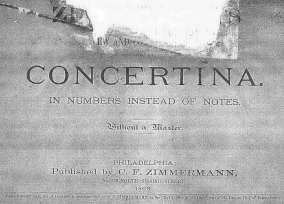
Added subsequent to original publication:
A101
Bäcker, Volker.
Konzertina—Schule.
Munich: Voggenreiter Verlag, 1995 (book and CD).
AVAIL
A102
Coleman, Albert W.
Coleman's New Instructions for the German Concertinas.
London: W. Coleman, 1854.
BL
A103
Edgley, Frank C.
Irish Traditional Melodies: Irish Session Tune Book.
Windsor, Ontario (CA): F. Edgley (with companion CDs, Volumes 1 and 2).
AVAIL (at http://www.concertinas.ca)
This tune book contains almost all of the tunes in
A24
and more than 60 additional tunes.
It qualifies as a tutor, given the instructional nature of the companion CDs. The first CD (Volume 1)
contains both slow and fast versions of the first 44 reels and jigs in the book. The second CD (Volume 2)
contains both slow and fast versions of the other jigs, as well as medium-pace versions of the
remaining tunes in the book. (Revised entry and annotation, December 2003.)
A104
Luschnitz-Merkelt.
Kleiner Konzertina Kursus. Neue Ausgabe.
Wiesbaden: Domkowsky & Co., c. 1880.
OSS
Translated as Small Concertina Course, New Release.
It contains no standard musical notation;
the tablature appears to be a variant of the notation by Carl F. Zimmermann (see
A100).
A105
Kirkpatrick (b. 1947), a long-time leading figure on the British folk music and Morris Dance scene, is a
professional player of the Anglo concertina, melodeon, and button accordion. His biography states: “And as
featured artiste, band member, or session player, his music can be heard on over 200 different commercial
recordings.” His on-line tutorial is a collection of three articles that were published in The Concertina Newsletter
(later Free Reed) in the early 1970s.
A106
De Snoo, Pauline.
Anglo Concertina Course.
Schijndel (NL): De Snoo, 2003 (CD included).
AVAIL (at http://www.concertina.nl)
Similar to the English concertina course
( E73)
in style and presentation, the tutor (available in Dutch or English) goes its own
direction to explain fingering, bellows directions, and other techniques for
the Anglo concertina. It is suitable for 20-key or 30-key Anglo concertina.
A107
Sheard’s Anglo-German Concertina Tutor.
London: Charles Sheard & Co., c. 1901-1920.
OSS
The dating is based on “196 Shaftesbury,” the post-1900 address of the Charles Sheard & Co.,
as shown on the cover.
A108
Day, Alan.
20-Button C/G Anglo Concertina Tutor.
Surrey (UK): Alan Day, 2003. (CD or audio cassette with sheet music supplement)
AVAIL (Contact Alan Day at
alan-jenny@decoverly.fsnet.co.uk.)
Focusing on English tunes, the recordings are designed for students who are adept
at learning by ear. Sheet music in standard musical notation for the tunes on the
cassette/CD, accompanied by some introductory comments, is also available from the
author on request.
A109
The introduction states that “It’s a draft in the sense that it will
eventually be expanded and improved by the contributions or suggestions
of those who read it. And it is supplementary in the sense that it is
not intended as an exhaustive guide to the instrument.” It contains many
useful tips and intermediate-to-advanced techniques—not described elsewhere—
for playing in the Irish style.
A110
Concertina Tutor for 10 and 20 Key Instruments.
London: Francis, Day & Hunter, c. 1880.
OSS
A111
Digby, Roger.
Faking It: The Booklet.
Prepared for the Annual General Meeting of the International Concertina Association, 23 October 2004.
AVAIL
A112
Worrall, Dan M.
The Anglo Concertina Music of William Kimber.
London: English Folk Dance and Song Society, 2005.
AVAIL
Thorough explanation of how to play in the Kimber style, along with transcriptions of all Morris
and country dance tunes that Kimber recorded.
A113
Anweisung das Accordion zu spielen.
Chemnitz, Saxony: Johann Gottlieb Höselbarth, c. 1840.
OSS
Though titled for das Accordion, the tutor is written for a single-row
concertina (main text) and a two-row concertina (Appendix titled
Anang. Zum zwei Reiichen Accordion). The tutor—possibly, the earliest tutor written
for German concertina—dates clear back to when, in Saxony, the German concertina
still was called an accordion or harmonika. According to Stephen Chambers
(who provided this entry), Maria Dunkel’s research and that of the
Musikinstrumneten-Museum in Berlin suggests that the author of the
tutor may have been Johann David Wünsch (1814-1895), a musician in
the Chemnitz orchestra and husband of Christiane Caroline Uhlig—daughter of
Carl Friedrich Uhlig (who invented the German concertina in 1834).
A114
Scates, Joseph.
Instruction Book for the Improved German Concertina.
London: J. W. Moffatt; and Dublin: Joseph Scates, c. 1852–55.
OSS
A115
Mitchison's New and Improved Tutor for the German Concertina.
Glasgow: Mitchison & Co, c. 1855.
OSS
Quite possibly a revised version of Mitchison’s Celebrated Concertina Tutor
( A55).
New and Improved in the title suggests an even earlier edition.
It appears that the Mitchison & Co. tutor catalogue was acquired
by George Cameron, or later by John S. Marr or John Cameron.
A116
Marr’s Concertina Tutor, a New and Greatly Improved Instruction Book.
Glasgow: J. S. Marr & Sons, c. 1880.
OSS
John S. Marr (later J. S. Marr & Sons) succeeded the firm of George Cameron, following George
Cameron’s death in July 1863. Marr & Sons was affiliated with John Cameron, who became the
firm’s manager by the mid-1870s. In addition to Cameron and Cameron & Ferguson editions, marketing
of the Concertina Preceptor ( A28) included
a version entitled Marr’s Concertina Preceptor, Or Pocket Guide to the Art of Playing the Concertina, c. 1875.
A117
Booth, Herbert H.
Instructions for the Salvation Army Concertina.
London: Salvation Army Book Stores, 1888.
OSS
The A73
annotation contained incomplete information about this tutor,
compiled by Herbert Booth, son of Salvation Army founder William Booth.
The full citation now can be provided (thanks to Stephen Chambers’s having
obtained a copy of the publication). As surmised in the A73 annotation,
this booklet is devoted exclusively to chording on the Anglo concertina.
The Salvation Army concertina refers to a Ab/Eb concertina with 26 keys,
the Salvation Army’s “standard issue” into the twentieth century.
Have feedback on this article?
Send it to the author.
Reprinted from the Concertina Library
http://www.concertina.com
© Copyright 2000– by Randall C. Merris
|
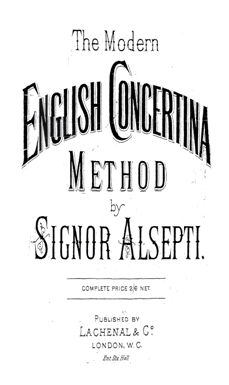
Signor Alsepti's Tutor
for English Concertina
Lachenal, c. 1895
Contents
The original version of this article appeared in The Free-Reed Journal, Vol. 4 (2002), pp. 85-118.
© 2002 Randall C. Merris.
Links to related documents
-
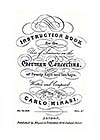 Earliest Known English-Language German Concertina Tutor: Minasi’s “Instruction Book” 1846
Earliest Known English-Language German Concertina Tutor: Minasi’s “Instruction Book” 1846
- by Randall C. Merris and Dan Worrall
-
Carlo Minasi published the earliest known English-language tutor for the German ("Anglo-German") concertina
by 1846 in London.
This publication goes well beyond the basics; in it are instructions not only
for the simple “along the row” melody line style, but also extensive discussions of octave
playing, cross row fingering, and chord accompaniment.
Numerous fully arranged musical selections are included,
almost all in the “English” or “harmonic” style, where chords are played on the
left and melody on the right, more or less as a duet concertina is played.
- Posted 15 August 2005
- » read full article
-
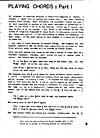 Playing Chords [for English, Anglo, and Maccann Duet]
Playing Chords [for English, Anglo, and Maccann Duet]
-
by Brian Hayden
-
"I would like to explain the system that I use when teaching
players about chords, their structure, and placement. Chords are
what I am most requested to explain at folk music workshops or
gatherings as I tend to use chords a lot in my own playing." (From
the introduction.)
Includes a novel notation for chords which is used elsewhere on this website.
As published in Concertina Magazine
(Australia) in three parts, 12-14 (1985), 12:5-7,
13:12-14, and 14:8-10; with corrections in 15-16 (1986), 15:14
and 16:1,6,9.
-
Posted 01 March 2004
-
» read full article in pdf
|


